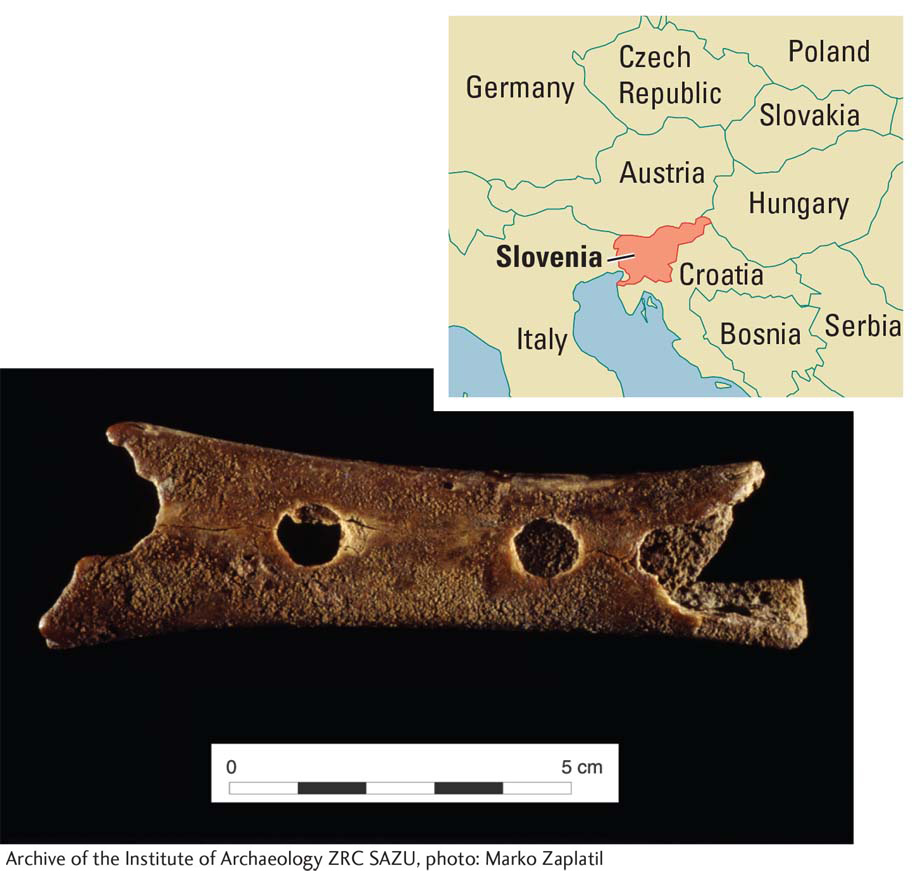Chapter Introduction
How Do We Hear, Speak, and Make Music?
RESEARCH FOCUS 10-
PHYSICAL PROPERTIES OF SOUND WAVES
PERCEPTION OF SOUND
PROPERTIES OF LANGUAGE AND MUSIC AS SOUNDS
STRUCTURE OF THE EAR
AUDITORY RECEPTORS
CLINICAL FOCUS 10-
PATHWAYS TO THE AUDITORY CORTEX
AUDITORY CORTEX
RESEARCH FOCUS 10-
HEARING PITCH
DETECTING LOUDNESS
DETECTING LOCATION
DETECTING PATTERNS IN SOUND
PROCESSING LANGUAGE
CLINICAL FOCUS 10-
PROCESSING MUSIC
CLINICAL FOCUS 10-
RESEARCH FOCUS 10-
BIRDSONG
ECHOLOCATION IN BATS

10-1
Evolution of Language and Music
The finding that modern humans (Homo sapiens) made music early on implies that music has been important in our evolution. Behavioral scientists have shown that music plays as central a role in our social and emotional lives as language does.
Thomas Geissmann (2001) noted that among most of the 26 species of singing primates, males and females sing duets. All singing primates are monogamous, suggesting that singing may somehow relate to sexual behaviors. Music may also play a role in primates’ parenting behaviors.
The human brain is specialized for analyzing certain aspects of music in the right temporal lobe, which complements the left temporal lobe specialization for analyzing aspects of speech. Did music and language evolve simultaneously in our species? Possibly.
Neanderthals (Homo neanderthalensis) have long fascinated researchers. The species originated about 300,000 years ago and disappeared about 30,000 years ago. During some of that time they coexisted in Europe and the Middle East with Homo sapiens, whom they resembled in many ways because they shared a common ancestor. In some locales, the two species may have shared resources and tools.
Researchers long hypothesized that Neanderthal culture was significantly less developed than that of early modern humans. Yet Neanderthals had a brain as large as or larger than that of Homo sapiens, with whom they appear to have shared many cultural similarities. Neanderthals buried their dead with artifacts, which implies that they held spiritual beliefs, but we have no conclusive evidence that they made visual art. In contrast, Homo sapiens began painting on cave walls some 30,000 years ago, near the end of the Neanderthal era.
Anatomically, some skeletal analyses of the larynx suggest that Neanderthals’ articulated language ability was less well developed than their Homo sapiens contemporaries’. What about music? It appears that Neanderthals did make music.
Shown in the accompanying photo is the bone flute found in 1995 by Ivan Turk, a paleontologist at the Slovenian Academy of Sciences in Ljubljana. Turk was excavating a cave in northern Slovenia used by Neanderthals long ago as a hunting camp. Buried in the cave among a cache of stone tools was the leg bone of a young bear that looked as if it had been fashioned into a flute.
The bone has holes aligned along one side that could not have been made by gnawing animals. Rather, the holes’ spacing resembles positions found on a modern flute. But the bone flute is at least 43,000 years old—
Bob Fink, a musicologist, analyzed the flute’s musical qualities. He found that an eight-
The similarity between Neanderthal and contemporary musical scales encourages us to speculate about the brain that conceived this ancient flute. Like modern humans, Neanderthals probably had complementary hemispheric specialization for language and music. This may have contributed to the two species cohabitating and to interbreeding that led to 1 to 4 percent of alleles being of Neanderthal origin in humans whose lineages, in the last 30,000 years, come from outside of Africa.

Language is independent of making or perceiving sounds, as sign language demonstrates. In this chapter, however, language refers to speech.
Language and music are universal among humans. The oral language of every known culture follows similar basic structural rules, and people in all cultures make and enjoy music. Music and language allow us both to organize and to interact socially. Like music, language probably improves parenting. People who can communicate their intentions to one another and to their children presumably are better parents.
Humans’ capacities for language and music are linked conceptually because both are based on sound. Understanding how and why we engage in speech and music is this chapter’s goal. We first examine the physical energy that we perceive as sound, then how the human ear and nervous system detect and interpret sound. We next examine the complementary neuroanatomy of human language and music processing. Finally, we investigate how two other species, birds and bats, interpret and utilize auditory stimuli.